|
 Monday,
5 June: Monday,
5 June:
The
week of informal meetings preceding the twelfth sessions of
the subsidiary bodies (SB-12) of the UN Framework Convention
on Climate Change (FCCC) began with an initial briefing by
the Chairs of the subsidiary bodies. Following this, a workshop
was convened to consider the Protocol mechanisms, and informal
meetings were held to address: guidelines on Protocol Articles
5 (methodological issues), 7 (communication of information)
and 8 (review of information); FCCC Article 4.8 and 4.9 and
Protocol Article 3.14 (adverse effects); and land use, land-use
change and forestry
|
|
Opening
Plenary
|
|
|
|

 Michael Zammit Cutujar, [above
left] Executive Secretary of the UNFCCC, welcomed
participants to SB-12, and reminded delegates of the
Secretariat's role in facilitating and encouraging capacity
building activities.
Michael Zammit Cutujar, [above
left] Executive Secretary of the UNFCCC, welcomed
participants to SB-12, and reminded delegates of the
Secretariat's role in facilitating and encouraging capacity
building activities. |
|
|
|
|
|
 On the issue of technology transfer, Harald
Dovland (Norway) [above left],
Chair of the Subsidiary Body for Scientific and Technological
Advice (SBSTA), noted that the Friends of the Chair group,
established at a previous SBSTA session, could accept more
members, and would at some stage become a contact group,
possibly at SB-13. On the issue of technology transfer, Harald
Dovland (Norway) [above left],
Chair of the Subsidiary Body for Scientific and Technological
Advice (SBSTA), noted that the Friends of the Chair group,
established at a previous SBSTA session, could accept more
members, and would at some stage become a contact group,
possibly at SB-13.
|
|
 John Ashe (Antigua & Barbuda) [above right], Chair of the Subsidiary Body for
Implementation (SBI), said the goal of the informal meetings
was to make substantial progress and provide textual proposals
for the formal SB-12 sessions, taking place from 12-16 June.
He noted that the week's informal discussions would address:
guidelines under Protocol Articles 5,7 and 8; the Protocol
mechanisms; compliance; FCCC Article 4.8 and 4.9 and Protocol
Article 3.14; policies and measures; land use, land-use change
and forestry; and the development and transfer of technology. John Ashe (Antigua & Barbuda) [above right], Chair of the Subsidiary Body for
Implementation (SBI), said the goal of the informal meetings
was to make substantial progress and provide textual proposals
for the formal SB-12 sessions, taking place from 12-16 June.
He noted that the week's informal discussions would address:
guidelines under Protocol Articles 5,7 and 8; the Protocol
mechanisms; compliance; FCCC Article 4.8 and 4.9 and Protocol
Article 3.14; policies and measures; land use, land-use change
and forestry; and the development and transfer of technology. |
|
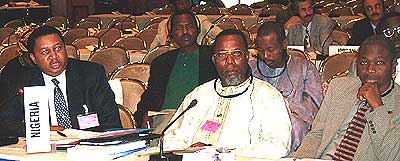
 Nigeria,
on behalf of the G-77/China, stated that the issue of
technology transfer should be put on par with other issues,
and to facilitate this he requested that the Friends of the
Chair be made a joint contact group. Nigeria,
on behalf of the G-77/China, stated that the issue of
technology transfer should be put on par with other issues,
and to facilitate this he requested that the Friends of the
Chair be made a joint contact group. |
|
|
Guidelines
Under Articles 5, 7 and 8 of the Kyoto Protocol
|
Co-Chair Plume identified the
objectives of the meeting as finalizing the guidelines under Article
5.1 (national systems), and making progress on the guidelines
under Article 8 (review of information) and methodologies under
Article 5.2 (adjustments). She proposed convening two subgroups
to address these objectives. In response to a request by the EU,
she agreed to hold a session to exchange views on Article 7 (communication
of information).
Co-Chair Paciornik suggested
that the issue of national inventories making reference to monitoring
of legal entities and/or projects under Articles 6 (joint implementation)
and 17 (emissions trading) be considered further at the meeting
scheduled on cross-cutting issues.
|
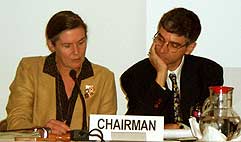
Co-Chairs Helen
Plume (New Zealand) [left] and Newton Paciornik
(Brazil) [right].
|
|

| Takahiko Hiraishi,
[above] of the Intergovernmental Panel on Climate Change (IPCC) |
|
Co-Chair Hiraishi (IPCC)
presented the Special Report on Good Practice Guidance and Uncertainty
Management in National Greenhouse Gas Inventories. Co-Chair Plume
noted that a side event will be devoted to it during SB-12.
|
|
Articles 4.8
and 4.9 of the Convention and Article 3.14 of the Protocol : Adverse
Effects
|
Co-Chair Reza Salamat (Iran)
proposed discussing FCCC Article 4.8 and 4.9 on Monday, and Protocol
Article 3.14 and procedural issues on Wednesday. He urged delegates
to build on the conclusions of the technical workshops held in
March.
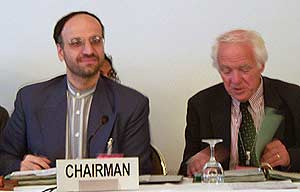
| Mohammed Reza Salamat (Iran)
[above left] and Bo Kjellen (Sweden)
[right]. |
|
 |
|
|
|
|
Mechanisms
Pursuant to Articles 6, 12 and 17 of the Protocol
|
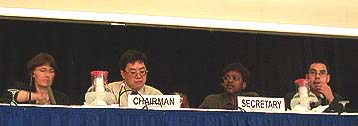
| Chow Kok Kee (Malaysia)
[second from the left] |
Workshop Chair
Kok Kee Chow (Malaysia) identified the key features of the
Clean Development Mechanism (CDM) based on work done on the mechanisms
since COP-5. He outlined the following steps in the CDM project
cycle: project identification and design; independent assessment
of project design; project submission to the Executive Board; monitoring;
independent assessment and verification of project performance;
and identification and distribution of certified emission reduction
units (CERs).
|
|
Land-Use,
Land-Use Change and
Forestry
|
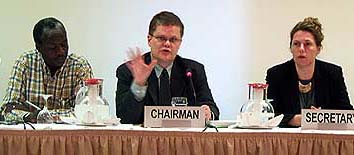 Co-Chair Halldor Thorgeirsson
(Iceland) identified key issues to be addressed during SB-12, including:
consideration of the IPCC Special Report; preparation of Parties'
submissions on land use, land-use change and forestry (LULUCF),
which SBSTA-11 requested by 1 August 2000; and draft elements of
decisions for COP-6. Regarding Parties' submissions, he noted a
decision taken at SBSTA-11 that SBSTA-12 consider reporting formats
for the submission of historical data and, where applicable, projections. Co-Chair Halldor Thorgeirsson
(Iceland) identified key issues to be addressed during SB-12, including:
consideration of the IPCC Special Report; preparation of Parties'
submissions on land use, land-use change and forestry (LULUCF),
which SBSTA-11 requested by 1 August 2000; and draft elements of
decisions for COP-6. Regarding Parties' submissions, he noted a
decision taken at SBSTA-11 that SBSTA-12 consider reporting formats
for the submission of historical data and, where applicable, projections.
| Co-Chair Halldor Thorgeirsson
(Iceland) [centre] |
|
|
In the corridors
Delegates expressed mixed views on the
expected nature of the informal meetings. While some felt they were
experiencing the "business as usual" atmosphere of formal subsidiary
bodies meetings, others saw the week ahead as a confidence-building
exercise. Although participants were cautious about predicting the
extent of progress likely to be made on contentious issues before
SB-12, many were generally optimistic
|